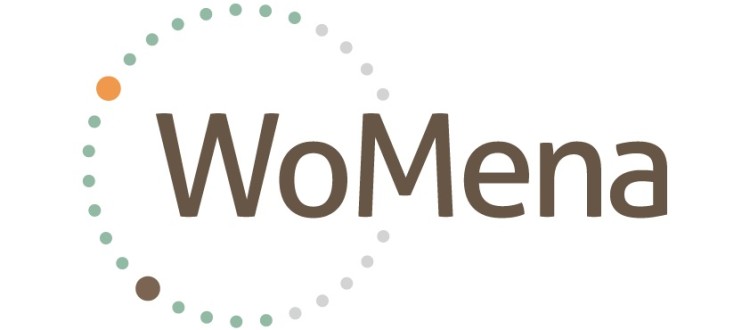Global Research Update #19
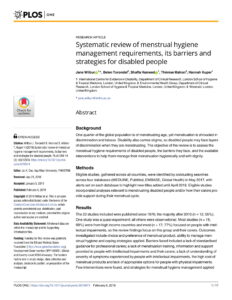 Wilbur et al. (2019): Systematic review of menstrual hygiene management requirements, its barriers and strategies for disabled people . This review assesses the menstrual hygiene requirements of disabled people, the available interventions to help them manage menstrual hygiene, and the barriers that both disabled people and carers face. Findings: there are only 22 peer reviewed studies explored the MHM requirements of disabled persons. This group reported low levels of satisfaction with the menstrual product used (sanitary pads, tampons), stating that they find the products uncomfortable, difficult to place and use with catheters. They also face challenges in understanding premenstrual syndrome (PMS) and communicating when in discomfort. Some people with intellectual impairments do not always understand or follow social and cultural norms such as inappropriate handling of menstrual blood and product, talking to others about their menstruation and changing the used menstrual product in front of others; carers reported this makes them feel stressed, embarrassed and they coped by not letting their daughters leave the home or sought ways to suppress their menstruation. Moreover, there is an absence of standards and training on providing menstrual care in the institutions, and professional carers dislike providing menstrual care. In addition, MHM training and support is not provided to family members, and that mothers also do not see how menstruation benefits their daughters. They also do not seek advice or support, because they view the provision of menstrual care as a private issue.
Wilbur et al. (2019): Systematic review of menstrual hygiene management requirements, its barriers and strategies for disabled people . This review assesses the menstrual hygiene requirements of disabled people, the available interventions to help them manage menstrual hygiene, and the barriers that both disabled people and carers face. Findings: there are only 22 peer reviewed studies explored the MHM requirements of disabled persons. This group reported low levels of satisfaction with the menstrual product used (sanitary pads, tampons), stating that they find the products uncomfortable, difficult to place and use with catheters. They also face challenges in understanding premenstrual syndrome (PMS) and communicating when in discomfort. Some people with intellectual impairments do not always understand or follow social and cultural norms such as inappropriate handling of menstrual blood and product, talking to others about their menstruation and changing the used menstrual product in front of others; carers reported this makes them feel stressed, embarrassed and they coped by not letting their daughters leave the home or sought ways to suppress their menstruation. Moreover, there is an absence of standards and training on providing menstrual care in the institutions, and professional carers dislike providing menstrual care. In addition, MHM training and support is not provided to family members, and that mothers also do not see how menstruation benefits their daughters. They also do not seek advice or support, because they view the provision of menstrual care as a private issue.
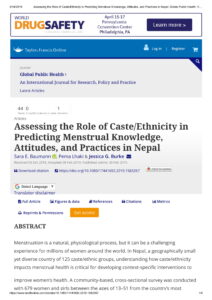 Baumann et al. (2019): Assessing the Role of Caste/Ethnicity in Predicting Menstrual Knowledge, Attitudes, and Practices in Nepal. A community-based, cross-sectional survey was conducted in 2015 with 679 women and girls of reproductive age, 13–51 years, from the most populous castes/ethnic groups in Nepal to understand how caste/ethnicity impacts menstrual health for developing context-specific interventions to improve women’s health. Findings: less than half (48.1%) of the respondents had high menstrual knowledge, 60% had positive menstrual attitudes, 58.8% had positive menstrual practices, and 88% believed that menstruation is a natural event. Caste/ethnicity and district type were significant predictors of menstrual knowledge, and caste/ethnicity and residence were significant predictors of menstrual practices in Nepal. The authors suggest considering caste/ethnic differences, the use of local languages, context-specific content, and indigenous beliefs to be incorporated into the design of menstrual health programs, as well as cultivating partnerships with indigenous health organizations, and developing outcome indicators disaggregated by caste/ethnicity.
Baumann et al. (2019): Assessing the Role of Caste/Ethnicity in Predicting Menstrual Knowledge, Attitudes, and Practices in Nepal. A community-based, cross-sectional survey was conducted in 2015 with 679 women and girls of reproductive age, 13–51 years, from the most populous castes/ethnic groups in Nepal to understand how caste/ethnicity impacts menstrual health for developing context-specific interventions to improve women’s health. Findings: less than half (48.1%) of the respondents had high menstrual knowledge, 60% had positive menstrual attitudes, 58.8% had positive menstrual practices, and 88% believed that menstruation is a natural event. Caste/ethnicity and district type were significant predictors of menstrual knowledge, and caste/ethnicity and residence were significant predictors of menstrual practices in Nepal. The authors suggest considering caste/ethnic differences, the use of local languages, context-specific content, and indigenous beliefs to be incorporated into the design of menstrual health programs, as well as cultivating partnerships with indigenous health organizations, and developing outcome indicators disaggregated by caste/ethnicity.
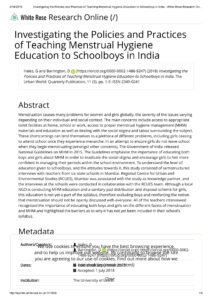 Hales et al. (2019): Investigating the Policies and Practices of Teaching Menstrual Hygiene Education to Schoolboys in India. Semi-structured interviews were carried out with school teachers from six different state schools in Mumbai, Maharashtra in India to understand what is being taught to boys through exploring the status quo of menstruation discussions within the school environment, the formal education provided on menstruation, and the potential impacts of educating boys about menstruation. Findings: Neither the girls nor boys were being taught about menstruation through the curriculum, but the girls were receiving classes on menstrual hygiene management (MHM) through a monthly pad distribution and disposal scheme (Pad Bank) while the boys were not only being excluded from the classes but also kept from knowing about the scheme’s existence. Moreover, many of the teachers mentioned that parents’ attitudes towards menstruation impede education at school settings. Teachers also emphasized the importance of educating both their male and female students on the different facets of MHM, not only to create an accommodating school environment for girls, but also to tackle the stigma and taboo surrounding menstruation, and creating the opportunity for boys to help and support their female friends and family at home.
Hales et al. (2019): Investigating the Policies and Practices of Teaching Menstrual Hygiene Education to Schoolboys in India. Semi-structured interviews were carried out with school teachers from six different state schools in Mumbai, Maharashtra in India to understand what is being taught to boys through exploring the status quo of menstruation discussions within the school environment, the formal education provided on menstruation, and the potential impacts of educating boys about menstruation. Findings: Neither the girls nor boys were being taught about menstruation through the curriculum, but the girls were receiving classes on menstrual hygiene management (MHM) through a monthly pad distribution and disposal scheme (Pad Bank) while the boys were not only being excluded from the classes but also kept from knowing about the scheme’s existence. Moreover, many of the teachers mentioned that parents’ attitudes towards menstruation impede education at school settings. Teachers also emphasized the importance of educating both their male and female students on the different facets of MHM, not only to create an accommodating school environment for girls, but also to tackle the stigma and taboo surrounding menstruation, and creating the opportunity for boys to help and support their female friends and family at home.
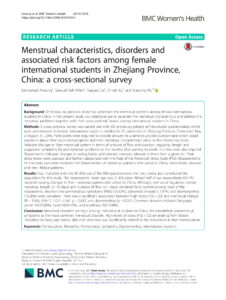 Ansong et al. (2019): Menstrual characteristics, disorders and associated risk factors among female international students in Zhejiang Province, China: a cross-sectional survey. A cross-sectional survey was done from May to August, 2016 among 409 female international students selected from 15 universities located in major cities in China to ascertain menstrual characteristics and the menstrual problems with their associated risk factors. Findings: almost half of the respondents (49.1%) reported varying changes in their menstrual pattern after arrival to China. Premenstrual symptoms (PMS) was most common menstrual disorders as 33.82% of participants reported experiencing it; the most predominant premenstrual symptom was headaches, followed by bloating and irritability and there was a significant connection between high stress and menstrual change and dysmenorhea; common forms of stressors were language barrier, food and loneliness.
Ansong et al. (2019): Menstrual characteristics, disorders and associated risk factors among female international students in Zhejiang Province, China: a cross-sectional survey. A cross-sectional survey was done from May to August, 2016 among 409 female international students selected from 15 universities located in major cities in China to ascertain menstrual characteristics and the menstrual problems with their associated risk factors. Findings: almost half of the respondents (49.1%) reported varying changes in their menstrual pattern after arrival to China. Premenstrual symptoms (PMS) was most common menstrual disorders as 33.82% of participants reported experiencing it; the most predominant premenstrual symptom was headaches, followed by bloating and irritability and there was a significant connection between high stress and menstrual change and dysmenorhea; common forms of stressors were language barrier, food and loneliness.
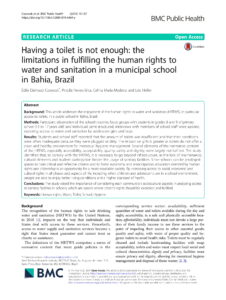 Coswosk et al. (2019): Having a toilet is not enough: the limitations in fulfilling the human rights to water and sanitation in a municipal school in Bahia, Brazil. A qualitative study explored access to water and sanitation by adolescent girls and boys aged 13 to 17 years in a public primary school in Bahia, Brazil was conducted among both 81 students and 89 staff to address the enjoyment of the human rights to water and sanitation (HRTWS), in particular access to toilets. Findings: there were not enough toilets, water, toilet paper and soap available and that the conditions of toilets were often inadequate because they were plugged or dirty; these conditions had a greater impact on girls as toilets do not provide a clean and healthy environment for menstrual hygiene management. The study also identified that cultural and social elements hinder the usage of sanitary facilities.
Coswosk et al. (2019): Having a toilet is not enough: the limitations in fulfilling the human rights to water and sanitation in a municipal school in Bahia, Brazil. A qualitative study explored access to water and sanitation by adolescent girls and boys aged 13 to 17 years in a public primary school in Bahia, Brazil was conducted among both 81 students and 89 staff to address the enjoyment of the human rights to water and sanitation (HRTWS), in particular access to toilets. Findings: there were not enough toilets, water, toilet paper and soap available and that the conditions of toilets were often inadequate because they were plugged or dirty; these conditions had a greater impact on girls as toilets do not provide a clean and healthy environment for menstrual hygiene management. The study also identified that cultural and social elements hinder the usage of sanitary facilities.

